This week we got to sit down with British builder Jeremy Williams (aka “Bricking It”). He lives in Leicester with his wife and two young sons (ages 5 and 6). He travels frequently, consulting for accounting firms and training their accountants. However, I was able to catch him between road trips and pick his brain. Come explore the mind of a builder with me!
TBB: Hey Jeremy, can you tell us how you got into LEGO?
Jeremy: Sure – I got into LEGO as a kid, and Classic Space was my era. I spent every evening building and playing with spaceships! I also got slightly into Technic, but never Castle or City. I then abandoned LEGO as a teenager and only picked it up again six years ago after my first son was born. I figured I had an excuse again!
TBB: Do you still use the kids as an excuse? Do they get to play with “Dad’s LEGO”?
Jeremy: My son’s birth was only an excuse because, as far as I knew, no other adults played with LEGO. Of course, as soon as I realized that there was this whole AFOL subculture and it was ‘legitimate’, I needed no excuse – and frankly, the Neo Classic Space stuff was so exciting I almost didn’t have a choice, I HAD to get into the game.
I have a standalone garage, half of which is a ‘LEGO room’ and so all my stuff is there – but all my current models are boxed up ready for events, and so they don’t get played with. The boys come in a fair bit (just to cause chaos). My elder son isn’t that keen on LEGO but my younger one is, and we often build sets together. He’s keen on City and Nexo Knights.
TBB: You mostly build Space creations. What is it that draws you to that genre? Also, can you explain Neo Classic Space for all the non-spacers out there?
Jeremy: Space is what interests me – it’s the legacy of Star Wars, Star Trek, BSG and numerous other shows that caught my imagination as a child. There’s endless possibilities to build, and lots of inspiration from concept art and movies. If I hadn’t got into LEGO a second time, I suspect I’d be kitbashing models of my favourite spaceships.
Because Classic Space was my thing as a kid, when I decided to look at LEGO again six years ago, I had no idea there was an AFOL community. All I’d got in mind was to try to buy some classic sets from eBay. But I Googled ‘Classic Space LEGO’ and discovered Neo Classic Space (NCS), and my future was decided!
NCS is a throwback to those classic space sets from 1978 – the same colours (blue, grey and trans-yellow) but with all the latest elements and building techniques. I just missed the 30th anniversary celebrations when a lot of AFOLs built NCS, but was inspired by their work – in particular, Peter Reid’s MOCs. I met Peter about a year after starting to build NCS and we’ve been in regular touch ever since. There’s a good group of spacers in the UK and we spur each other on to new ideas and challenges – we worked together on the LEGO Ideas Exo Suit launch, for example.
TBB: NCS is a great theme. You alternate between Microscale and Minifig scale ships, as well as between ships and interior shots, all while staying in the Space theme. How do you decide whether a ship should be build in Micro or Minifig scales? What drives one of your interior scenes?
Jeremy: I love Microscale, and the specific challenge of re-purposing elements to work at a small scale, but I’d have to say that Minifig scale is my dominant interest, because it replicates what I did as a kid, and having the human element makes it more compelling. And while I love spaceships, I find interior shots even more exciting – partly because there are fewer builders doing it, but also because it’s so ripe for imagination. The very best builders create an interior scene which has a cinematic quality – in certain cases, you stop seeing the LEGO elements for a moment and you’re drawn into the scene. Peter Reid’s interiors did that for me, and there are other builders who do the same. Getting the camera down to minifig eye level and lighting the build atmospherically produces spine-tingling results when done right.
Part of the choice is whether you’re building primarily for display at an event or for photographing on Flickr. With the former, you tend to want something that is complete – a building, or a spaceship – so people can make sense of it – my Ares 7 Rover fits into that category. On Flickr, you’re interested in one killer photo, from a specific viewpoint, so you don’t need to worry about anything off-shot. My Alpha Zero Niner corridors are a case in point; they are actually disjointed sections of corridor with lights and wires hanging out of them, but photographed from the right angle, they look like part of a film set. But controlling lighting becomes all important for the best, most atmospheric photos. Only a few MOCs work at both levels.
I’m also obsessed with corridors, hangar bays, engine rooms, all of that set design which the Star Wars series and others get so right. I think many spacers watch sci-fi for the set design, rather than the plot! I could talk about conduit piping and bulkhead doors for hours… Of course, if you put a stunning, well-lit interior into a giant spaceship (or put a ship in a top-notch hangar bay) you’re in space heaven.
TBB: Those interior shots are beautiful. How do you decide what scale or techniques you are going to use in a new build? How much planning goes into your builds? Do you sketch them out first or just start putting pieces together and see what comes out?
Jeremy: There are various triggers to my build process. For example, my recent DART spaceship is based on a new trans-yellow windscreen that simply had to be used (NCS builders love trans-yellow parts with a peculiar passion!). I made a Microscale Arrowhead spaceship for a similar reason; I found a trans-yellow part on BrickLink (a Hero Factory armour piece) and built a spaceship around it.
In other cases, it’s a technique that starts everything. For my Reactor One model, it was the circular walkway, made of 1×6 plates with a 1×1 plate on the endmost stud, repeated to form a circle. I found this almost by accident, and I instantly thought of vertical shafts, such as the ‘tractor beam deactivation’ scene in Star Wars ANH or the warp core in Star Trek TNG, and the build went from there. Along the way you discover new ideas – in that case, I bought some electroluminescent (EL) wire that fits neatly through an axle-hole – so I could create a lit ‘beam’ running vertically. I’m not a purist when it comes to lighting effects (and have occasionally dyed trans-clear windscreens to simulate trans-yellow) although I don’t otherwise cut, paint or glue elements.
Some builds are planned out in depth. My Alpha Zero Niner corridor was fully planned in Ldraw and then built from plan. I will sometimes start in Ldraw to play around with ideas, then move to LEGO and experiment from there. Ldraw is great for trying out ideas, and very useful when I’m stuck in a hotel room, but it’s not nearly as fun as the real thing. I also tend to build badly on Ldraw – it will let you place elements with no physical connection, and sometimes it’s only when I try to build the model that I realize key sections aren’t connected to anything! And there’s no substitute for playing with tablescraps and seeing what emerges.
TBB: Is there one of your builds that is your favorite? Are there any builds that you really struggled with to get to turn out well? Is there anything that you wish you could build but it keeps defeating you?
Jeremy: I think I struggle with every build! I work slowly and have to keep reworking sections until I’m happy (or until I’ve run out of time). My favourite build so far has been the Ares 7 Rover, because it meant learning how to build a Technic chassis with steering and motors, while also working on the detail of the cab and the interior, and my first use of custom stickers – so it presented several new challenges and I was very pleased with the result. But it was also the biggest struggle and there were several stages where I thought it wouldn’t work at all.
My least favourite is almost all of them! I rarely have a build that I don’t wish was different in some aspect. For example, one tricky thing regarding spaceships is to make them attractive from all angles. I’ve built a few that look downright ugly from the wrong viewpoint, and it’s usually the result of bad planning. It’s easier to get right on smaller ships, and I’ve been pretty happy with the last couple I’ve done in particular.
TBB: Please tell us more about your Ares 7 rover. It’s an incredible build! What were the challenges? What was it about that rover that inspired you?
Jeremy: The rover was directly inspired by the Matt Damon/Ridley Scott film ‘The Martian’ and the original book by Andy Weir. Man, I loved that book/film in a way I didn’t expect, as although it’s sci-fi, it’s based on near-future NASA missions. I watched the film a dozen times, and particularly loved the rover, but I thought that building the distinctive windscreen with its hexagonal windows was impossible. Then I discovered that the large flag element came in trans-black. That set off the mission to recreate a version of the movie rover.
I quickly realized that, at minifig scale, the window would make the rover considerably bigger than the movie version, so I decided to go with a larger vehicle. I immediately decided it should be motorized and I’d have to learn about steering and suspension (both front and rear axles steer, are driven and have independent suspension) and a detailed interior. I researched NASA prototypes and went from there.
A particular challenge was lighting – I wanted to put lights in the roof which was removable, so I needed a compact battery-powered solution. A third party company, Brickstuff, makes such a pack and I had to integrate it so that I could easily switch it on and off and change batteries, but it was concealed. That was fun to do.
The Rover made the TBB top ten shortlist for 2016 which was amazing for me, given the stellar standard of TBB-blogged models. I’m so glad other people like it! It’s been to Skaerbaek and is doing the rounds of UK events.
The best part was that the National Space Centre, thanks to our contact from LEGO events, let me go in before opening hours to film the rover driving on their simulated Martian surface.
TBB: That video is awesome. I love that they let you do that. So, how important is the LEGO fan community to you and your builds? Are you only involved online via Flickr or do you attend conventions and/or a local club or LUG?
Jeremy: I’m a member of the Brickish Association, and we hold events several times a year which are really valuable times to catch up with the community – I’ve organised one of our larger events at the National Space Centre for a couple of years. But I think the (UK and global) spacer community is the most important thing to me, and hanging out with builders such as Peter Reid, Tim Goddard and Drew Hamilton is especially exciting. Those guys are seriously good at what they do and there’s some friendly rivalry that is good for building. There are others online that I’ve never met but we communicate via email and Flickr comments.
I visit Flickr, TBB and a couple of other sites daily, and although I don’t post on forums regularly, I like to follow what’s happening.
TBB: That a good group of builders with whom to hang out. If LEGO were edible, what part or color would be your favorite?
Jeremy: Wait, it isn’t edible? Cheese slopes in Medium Nougat are very hard to resist. Less so under the BrickLink colour name Medium Dark Flesh!
TBB: No doubt! If you could be in charge of one thing at the LEGO company and push it through to completion, what would you make them do?
Jeremy: Monorail. And inverted cheese slopes. (Mmmm, cheese). More seriously, I think the old 9V system which embedded electrical contacts into plates and included light and sound bricks should have been developed. The proliferation of non-LEGO lights in use by AFOLs should tell TLG that the current Power Functions lights aren’t good enough. I’d like to see smaller motors (a return of the micromotor!) and LEDs that more easily integrate into sets, such as the Modular buildings and UCS Star Wars sets.
TBB: I think everyone wants inverted cheese slopes! What’s your greatest fear?
Jeremy: Being buried alive under a mountain of Friends sets.
TBB: Well, if you have to go …there are worse ways! Thank you for taking time with us. What is the next adventure for Jeremy Williams?
Jeremy: I’m currently working on a replacement for Cayman, my SHIP from 2013. The new one will be bigger, with more space and more functions, too – a fully kitted out interior including lots of sliding doors (a must for sci-fi) and lighting. It’s a slow process but the result should be worth the wait!
TBB: Can’t wait to see it!



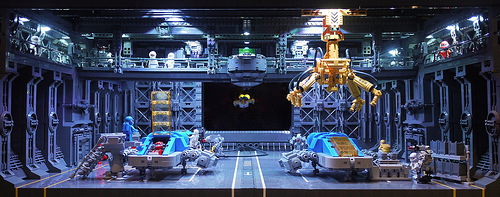



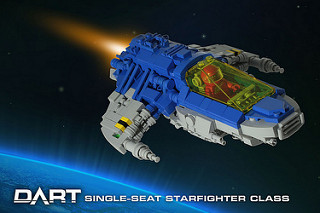


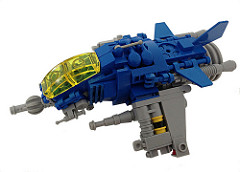

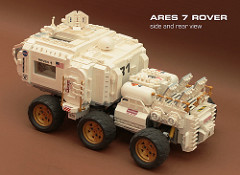


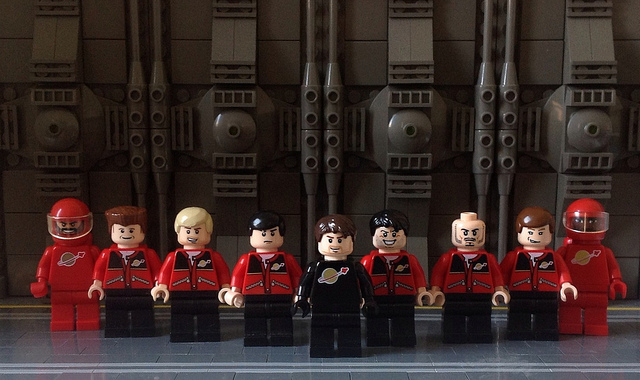




Heh. I’ve regularly had people viewing our club layouts ask me what my personal layout looks like at home, and I always get the weirdest looks when I inevitably respond with, “stacks of black suitcases in the hall”. I’ve also made the mistake of designing a model in LDraw only to find out when I built the first physical copy that it was made in two completely unattached sections. I did a quickie fix by adding an unplanned roof and a 2×12 plate across the bottom (to date, probably still the ugliest underside I’ve ever designed for a car). However, these days I’m so much more comfortable designing in LDraw. I can shape the outer body for a car just by placing bricks, plates, slopes, and other parts to get the look I want, and then it’s a lot easier to figure out what has to go on the inside to make everything connect together. If I do it with bricks, every tiny little change I want to make to the outside can involve tearing apart the entire base because space constraints are so tight on the interior build of a 6-wide car.
But, as neat as it is to run across someone who feels a bit more like a kindred spirit than some of the guys who freehand fancy buildings, I’m actually posting about something a bit more serious. I know it can be a bit weird, from a social standpoint, but I hope you periodically test your wedding ring to make sure you can still remove it from your finger. My dad let his go longer than he should have, and by the time he realized it was too tight, he had to have it cut off of his finger before they could resize it by adding in some material. The tricky part was, there’s an inscription on the inside of the band, but being just a plain band there was really no way to guarantee they wouldn’t cut right through the inscription. In the end, he got lucky. They missed the inscription by a comfortable enough margin, they were able to resize it using all of the original metal with some new added for extra girth, you can’t tell that it was ever modified, and it didn’t get quite so bad as to start cutting off circulation in his finger.
If you see this, please build a model of NASA Space Launch System and the Orion Crew Module and Service Module that can fit the minifigs